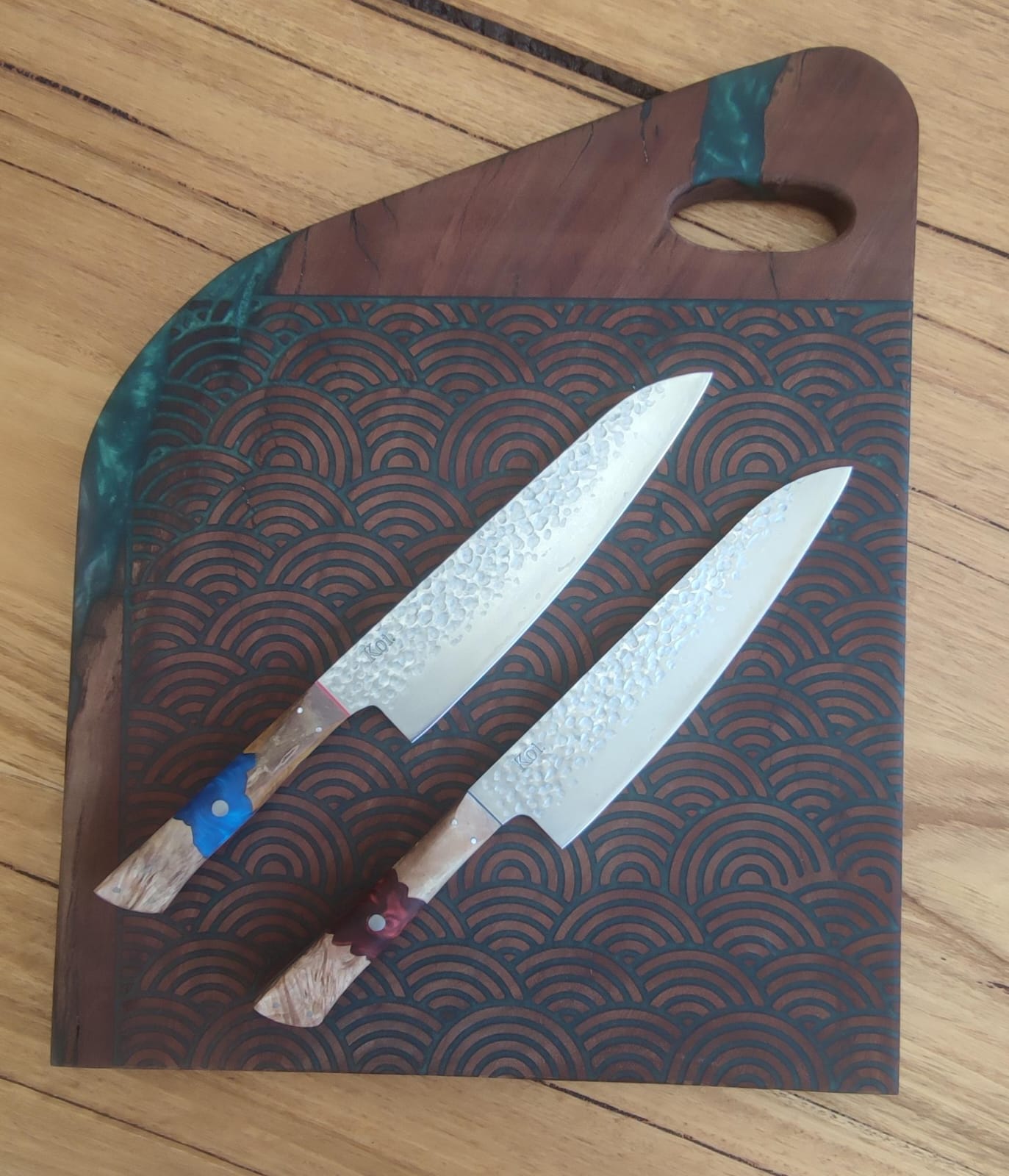Japan has a rich history of fine blade making, from the combat weapons of the samurai, to the impossibly sharp sushi knives of master chefs today. Today we will look through some of the styles and techniques that shape the blades and the reasons for each.
The "crafting" procedure produces the Ji (metal body part), which is the foundation of a Japanese knife. It is often created by forging steel and iron together, tempering the metal by repeated hammering. There are more than ten processes that take a lot of time and also the artisans' expert talents.
All Japanese knives, however, are not made equal. Manufacturers and blacksmiths use a variety of methods to accomplish various goals. Let's discuss the techniques these guys use to reach true slicing perfection!
SAN MAI
- Three layers of steel
- San-Mai knives are always double-beveled
What is San Mai steel? San Mai steel is renowned for having excellent cutting performance and incredible toughness, being forged and shaped into blades. However, the method used to create San Mai steel is entirely distinct, and as a result, it has a unique set of characteristics that other types of steel do not.
San Mai steel is Japanese in heritage and is made with a specific composition and design technique. Its name loosely translates from the Japanese to mean "three parts," which perfectly describes how these blades are constructed.
Knife-makers go through a unique process to make San Mai blades, which gives these blades their well-known and well-recognised characteristics. We must first discuss how smiths distinguish its constituent parts to answer the question of how to create San Mai steel.
Metalworkers choose which steel to employ for the inner and exterior parts according to its carbon density; the more carbon steel has, the "harder" it is. The more rigid metal will be placed between two identical pieces of the softer steel, and then they will be forged to join together.
When the blade is correctly sharpened, the softer, shatter- and corrosion-resistant steel forms a protective covering around the centre of the tougher steel, barely exposing it to the thin edge. Sometimes referred to as cladding, the reason to use two types of steel (one for the cutting edge, one for the cladding) is to get the best out of both types of steel. Harder steel is more likely to rust, so using softer steel in the cladding will make the entire knife more corrosion resistant. It will also decrease the chances of the blade chipping or breaking.
This in-depth understanding should have helped clarify the frequently asked question, "What is San Mai steel?"
NI-MAI
- Two layers of steel
- Ni-Mai are single bevel knives
Similar to how the san-mai protects the tougher steel, single bevel knives are often forged using a process known as ni-mai, which translates to "two layer." The idea behind single bevel knives is the same as san-mai knives: the cutting action is carried out by a single layer of softer steel that is forge-welded onto the knife's face to prevent it from becoming overly delicate.
Ni-Mai knives with a single bevel are sharpened and honed very differently. These knives have a non-stick quality due to the hard concave steel on the back of the blade. This will also mean that both sides of the blade will have different characteristics, the interior concave cutting edge will be harder and more likely to rust and patina, where as the wedge shaped softer cladding steel will be more resistant to corrosion and less likely to chip.
MONOSTEEL
- One layer of steel
As the name suggests, these knives are made with one kind of solid steel that is inherently scratch-resistant rather than laminated. The surface of a mono steel blade is often finished to a mirror-like shine, is plain, and has a simple shape. The steel is generally of a higher carbon content making it incredibly sharp, but more brittle without the cladding. Best used for delicate cutting such as sushi.
HONYAKI
Single-layered or mono steels are further categorised into Honyaki blades, which use an older and more archaic method of knife manufacture. Honyaki are uniformly tempered blades, where the entire blade is of the same hardness and martensitic composition.
Although less than 1% of all knives in Japan are Honyaki forged, many knife enthusiasts believe the blades produced are the best on the planet. The Honyaki blade is made from a single piece of steel and is quenched twice. It is done through a differential heat quenching process where the edge develops an intricate martensitic structure.
Also, the blade maintains its sharpness for a very long period while the spine remains softer and functions as a shield like the lamination does in other knives.
The Honyaki knives are made by only the most skilled master blacksmiths because this process is challenging to use and execute. They are only suitable for professional chefs because they are uncommon, expensive, and fragile. They are highly valued for their Kirenaga, or edge retention, abilities because they can keep their sharpness for a very long time.
The Honyaki's can either be (double bevel) both sides sharpened or (single bevel) sharpened on one side.
WARIKOMI
- Used on double bevel blades
Knives have a firm core that only extends to the width of the blade's middle, positioned between plies of softer steel. This particular structure style is used for difficult-to-forge steels, such as some varieties of powder steels. A piece of steel is put into a split, blazing-hot piece of iron. The newly formed steel is now a single unit. This results in a solid kitchen knife with a little more flexible core. These knives' key benefits are that they are small, razor-sharp, and keep their edge exceptionally well. Another name for Warikomi is the "split and insert technique."
KOBUSE
Two different kinds of steel are used in the construction of the Kobuse. Moreover, the San Mai approach has a different architecture than this one. The Kobuse contains mild steel at the centre and hard steel outside, unlike the San Mai, which uses softer steel in the exterior layers while safeguarding the more rigid steel core.
In Japanese swords, the core was made of Shingane steel, while the edge was made of Hagane steel.
HONSANMAI
Kobuse and Honsanmai are comparable in that the former uses hard steel on the outside and softer steel in the middle. The hard steel is coated with an additional layer, which makes the difference. Typically, this is Kawagane steel, Japanese steel with exceptionally high carbon content.
MARU
Maru, also known as Moku, is a Japanese forging process that uses only one type of steel. This steel type is often high-carbon steel. Given that they are manufactured of a single type of steel, Maru knives make up the majority of Japanese knives.
Conclusion
Bladesmiths use various forging techniques in addition to the Japanese forging methods mentioned above to create knives and blades. The steel produced through these forging processes has different properties.
So, which technique is excellent? The best knife is..? Well, that relies entirely on your tasks. Ultimately, blades constructed of the most rigid steel maintain their sharp edge the longest. Although san-mai, ni-mai, and honyaki knives are the most effective in this regard, they might not always be the best option. There is no shortage of reasonably priced san-mai knives, but they could be too delicate and brittle for demanding tasks like hacking through bones or partially frozen food.
The best balance is softer steel core for heavy tasks (like chopping pumpkins), and harder steel for delicate tasks (like slicing fish for sashimi). With high quality knives, it is important to understand the intended purpose for the knife, in order to find its true potential.




